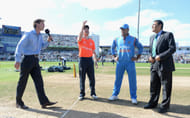Ad
Sometimes a silly convention at the start of an endeavour can get stuck as a tradition, even when the endeavour in itself has evolved enough to suit the demands of time; one such phenomenon is the “toss” in cricket that decides who bats or bowls first in a game. The first known law regarding toss was way back in 1744 when the winning captain could choose which pitch to bat on along with whether to bat or bowl first.
Ad
But, by about 1809, this rule was scrapped in favour of umpires choosing the wicket and the winner of the toss deciding whether to bat or to bowl first. However, those were different days. Those were the romantic days of the exclusively white flannels, teams travelling to countries by ships, men playing the sport for the sheer joy of it and not as a “profession”. It was an old world of chivalry and romance and the quaint asymmetry of awarding an important decision in the match – such as batting or bowling first – on the basis of the toss of a coin could be overlooked with customary magnanimity.
Ad
Ad
But, since then, the game has come a long way. Nowadays, international outfits zing back and forth to playing locations in jets and multi-task short tournaments. They play in coloured flannels, don’t tolerate more than 1 bouncer per-over (2 in Tests), execute shots like “reverse-scoop”, and finish matches inside 3 hours. In such a scenario, the inherited antiquity of a coin-toss is nothing more than a misfit.
Ad
Home-away can’t be a solution
Stuart Work writes for The Cordon that a coin toss should be done away with in favour of the visiting team being asked to choose and letting the opposition captain and umpires know their decision 30 minutes prior to the match. Also, he wants the hypocritical presumption that ground-staff and pitch-curators are acting in neutrality to be banished. The home captain should be allowed to openly instruct the pitch curator as to what sort of surface they would prefer, etc.
Ad
Ad
This is not a new idea; this kind of a practice was in place long ago, at around 1700s. But the problem with this theory is that, presently, competitions don’t only revolve around bilateral Test tours. It’s a lot more diverse with one-dayers, triangulars, T20s, World Cups and other tournaments. Therefore, it would probably make more sense if the choice is made based on rankings.
Ad
‘Rankings’ the way forward
For instance, imagine a bilateral tour is structured in the following way: Tests, One-dayers and T20s. Ahead of the first Test, the lower-ranked team would be asked to choose to bat/bowl. Based on the result of the match, the winner would decide in the next Test. If the game is a draw, then the rankings are reverted to.
Ad
Ad
Apart from ensuring parity, this would give an added incentive to the teams to win, as well. This should be the approach for ODIs and T20s, too. The one drawback that’s going to remain with this formula is that one has to contend with the rankings system, which is not always uncontested and satisfactory. Sometimes, weaker teams on the ground might be ranked higher; however, the counterpoint to that is that getting to choose to bat/bowl is not necessarily an advantage if we assess the modern results.
Ad
Ad
In this article, S. Rajesh has explained with stats that how – since the 1980s – batting first hasn’t been an advantage for teams. And, in Test matches, batting first is something that most captains winning the toss opt for. In their 2013 tour to India, Australia won all four tosses but lost the series 4-0. Clearly, then, winning the toss isn’t as big a factor as is made out. There have been countless instances when teams being put in to bat after losing the toss have actually found it a boon.
Ad
Ad
Many a captain choose to bowl first hoping to get early purchase from the wicket, only to pay the price as the opposition batsmen weather the early storm and then pile on the bowlers’ misery as the pitch flattens out. Anil Kumble – who captained India from 2008-2009 – also reiterated the fact that the team should not rely on factors that they cannot control such as the toss. He wanted the team to make it a habit of expecting results on the basis of the performance they put in.
Ad
Ad
Based on all the evidence, one can safely say that the effect of the toss is not too big. However, being a sport of a much different nature to, say, tennis, hockey or football, the practise of deciding to bat or bowl first – as opposed to choosing to serve in tennis or the end in football – should not be left to the toss of the coin. In the place of toss, one can adopt the above mentioned formula. The disparity will still remain because the rankings will be one of those residual vagaries of the game that cannot be obliterated. However, as I just explained, the resultant difference will not be much.
Ad
Improving the rankings system will make the idea more meaningful, as in a home-win and an away-win can be measured in different scales to arrive at the actual quality of a side.
Looking for fast live cricket scores? Download CricRocket and get fast score updates, top-notch commentary in-depth match stats & much more! 🚀☄️
Edited by Staff Editor

